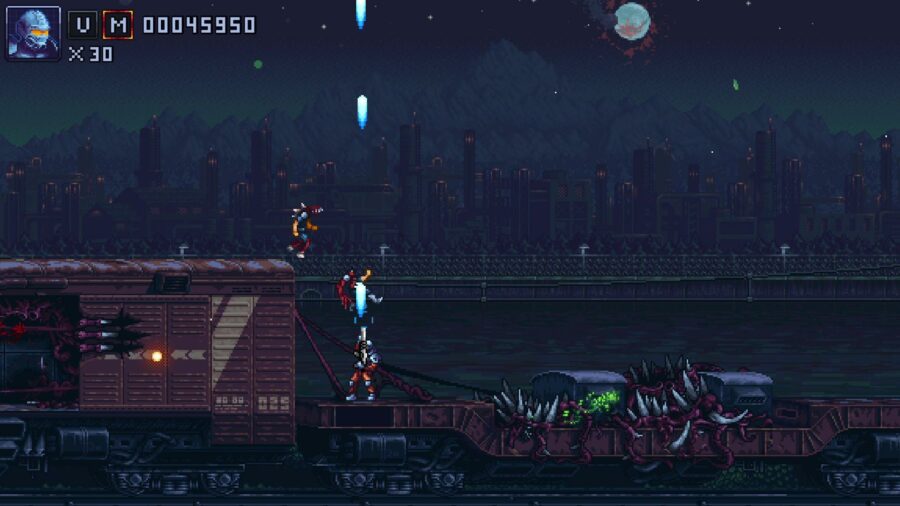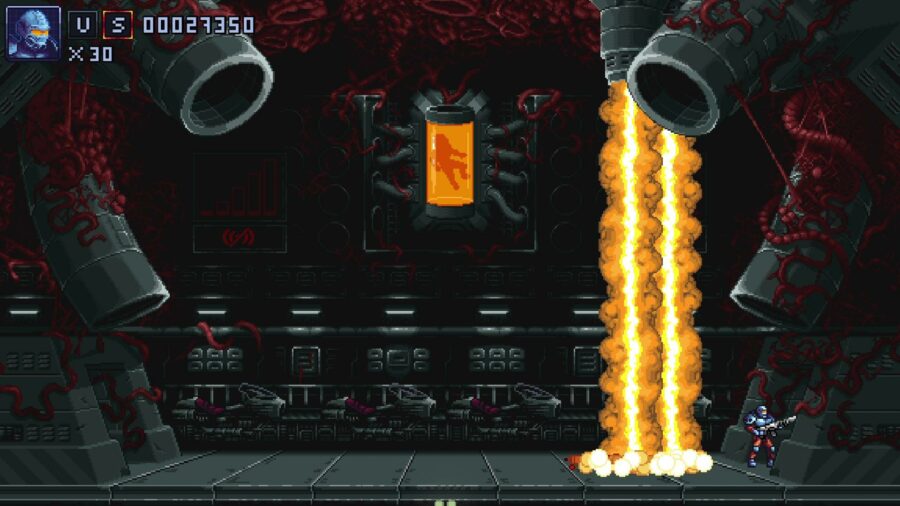For the last few years, Konami has been notoriously uninterested in making games. It has a proud 40-year-old legacy of classics, the most famous of which are Metal Gear, Castlevania, Silent Hill, Suikoden, and Contra, but made a deliberate shift towards the mobile and pachinko markets in 2015.
While Konami’s put out a few things recently, such as this week’s Silent Hill 2 remake, February’s Contra: Operation Galuga, and the recent Castlevania DS collection, it’s let many of its franchises wither on the vine. If you’re any kind of long-time video game fan, it’s been a point of frustration for a while.
That frustration has apparently hit Retroware particularly hard, because its recent product lineup looks like a blatant attempt to rebuild Konami from the ‘80s on up. The forthcoming The Transylvania Adventure of Simon Quest appears to be an attempt to ask the question, “What if Simon Belmont was a douchebag?” and Iron Meat is described on its own Steam page as a “Contra-like.” These are shameless men who have set about a shameless task.
I’m giving them shit – I feel I have no choice but to give them shit – but I can’t say they’ve done it badly. Iron Meat is a Contra game by David Cronenberg on surprise acid, packed fat with body horror and arcade-style challenge. Like Contra, it’s designed to encourage you to go for a one-credit clear, but it’s got a few modern quality-of-life features that take some of the sting out of learning each level’s patterns.

At the start of Iron Meat, an unspecified experiment opens a portal to another dimension. The entity that spills out, the Meat, is instantly hostile and turns everything it touches into a cyborg abomination. Humans become half-machine drones, while everything from crates to vehicles to buildings become carnivorous nightmares.
You’re one of the troops trying to fight this invasion back by any means necessary. Early on, you’re fighting little skirmishes against the forces of Meat, but eventually it turns into a full panicked retreat. This is all told through the story that’s happening in the background as you blast through hundreds of Meat-created monsters, as the war takes you from the human holdouts’ facilities to a confrontation on the moon. There’s actually a fair amount of story here for a game that has placed absolutely no emphasis upon it.
Describing the gameplay feels mildly redundant, as the gameplay is Contra, and it feels like everyone who’s ever wanted to play Contra has had the opportunity to do so by now. You are a square-jawed action archetype with a gun who runs across the screen shooting everything that gets in your way. Despite your visible grit and ability to do infinite triple flips, you die from the mildest touch of enemy action.
While Iron Meat does load you down with extra lives – Normal difficulty gives you 15, and they’re restocked between levels – you also lose your current weapon if you die. It borrows the weapon-swap mechanic from Contra III, where you can keep a gun in reserve through death, but you’re still at an immediate, distinct disadvantage whenever you lose a life.
The idea is to learn each level so you can glide through it without taking a hit, which rewards you by letting you keep your big overpowered guns on hand to blow the stage boss into component atoms. This is a game that’s been made to be mastered.
It’s also got some of the craziest enemy design of anything I’ve played this year. Iron Meat is set in a world perched between any given Iron Maiden album cover and ‘90s skateboard art, where absolutely anything could sprout a fanged maw and try to kill you. I thought the giant semi-organic bullet train would prove to be the limits of its ingenuity, but then I ended up in a pitched fight against a possessed apartment building. If there’s one thing you have to see in Iron Meat, it’s the flesh/robot monsters, and some of the best are saved for the last couple of stages.

The biggest problem Iron Meat might have is that it doesn’t always do a great job of indicating where it is and isn’t safe to stand. There are a number of levels where you’re supposed to navigate a situation by jumping to ledges that are colored like they’re meaningless parts of the background. It’s nothing you can’t learn from repetition, and the entire game is built around replaying the same 11 stages for high scores, but it’s obnoxious on an initial run.
Its second biggest problem is that it came out the same year as Operation Galuga. Iron Meat has a more classic style and arguably better design, and it was mostly made by one guy in Russia, so you have to grade it on a curve. It’s still got the problem where it was made in homage to a classic series that abruptly came out of hibernation a full eight months before its release, in what analysts sometimes (do not) call a “Bubsy 3D” scenario.
Iron Meat is ten bucks cheaper than Operation Galuga, though, and it’s worth clearing at least once for the experience. It’s only about an hour long, with enough of that old-school style that you’ll probably want to immediately go back through it on the next highest difficulty. It’s got 1995’s graphics with 1985’s gameplay, and if that sounds like fun to you, you’ll enjoy Iron Meat.
[Iron Meat, developed by Ivan Suvorov and published by Retroware, is now available for PlayStation, Xbox Series X|S, Nintendo Switch, and PC via Steam, Epic, Itch, and GOG for an MSRP of $19.99. This review was written using a Steam code sent to Hard Drive by a Retroware representative.]
This article is satirical. Hard Drive is a gaming/tech satire site. All content should be considered parody and entertainment purposes only.



